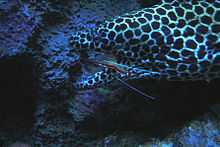Cleaner shrimp

Cleaner shrimp is a common name for any swimming decapod crustacean that cleans other organisms of parasites. This is a widely cited example of cleaning symbiosis: a relationship in which both parties benefit. The fish benefit by having parasites removed from them, and the shrimp gain the nutritional value of the parasites. In many coral reefs, cleaner shrimp congregate at cleaning stations.
In this behaviour cleaner shrimps resemble cleaner fish, and sometimes actually may be seen to join cleaner wrasse and other cleaner fish attending to client fishes.
Cleaner shrimp may belong to any of three families, Palaemonidae (including the spotted cleaner shrimp, Periclimenes yucatanicus and Periclimenes magnificus), Hippolytidae (including the Pacific cleaner shrimp, Lysmata amboinensis) and Stenopodidae (including the banded coral shrimp, Stenopus hispidus) .[1] The last of these families is more closely related to lobsters and crabs than it is to the remaining families. The term "cleaner shrimp" is sometimes used more specifically for the family Hippolytidae and the genus Lysmata.
Cleaner shrimp are often included in salt water aquaria.
Behaviour
Shrimp of the genus Urocaridella are often cryptic or live in caves on the reef and are not associated commensally with other animals.[2] These shrimp assemble around cleaning stations where up to 25 shrimp live in proximity.[2] When a potential client fish swims close to the cleaning station, several shrimp perform a "rocking dance", which is a side-to-side movement to attract the client. Starved shrimp rock more frequently to remove and ingest the ectoparasites than hunger-satisfied shrimps.[3] The increased frequency of the rocking movement suggests there is competition between the shrimp that need the nutritional aid of the fish and the shrimps that are satisfied.[2]
References
- ↑ "Cleaner Shrimp". Wetwebmedia. Retrieved 2006-08-15.
- ↑ 2.0 2.1 2.2 Justine H. A. Becker, Lynda M. Curtis & Alexandra S. Grutter (2005). "Cleaner shrimp use a rocking dance to advertise cleaning service to clients". Current Biology 15 (8): 760–764. doi:10.1016/j.cub.2005.02.067. PMID 15854910.
- ↑ J. H. Becker & A. S. Grutter (2004). "Cleaner shrimp do clean". Coral Reefs 23 (4): 515–520. doi:10.1007/s00338-004-0429-3.
.jpg)